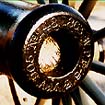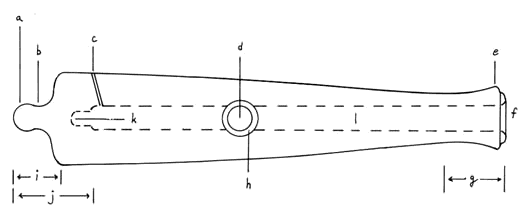Basic Terminology
This is a schematic of a Napoleon, with the addition of a chamber purely for illustrative purposes. (From Dean S. Thomas, Cannons: An Introduction to Civil War Artillery)
| a – knob b – neck c – vent d – trunnion e – muzzle swell f – muzzle face |
g – muzzle h – rimbase i – cascable j – breech k – chamber l – bore |
Nomenclature
By the early nineteenth century artillerists in most western countries had settled on a standard method of naming cannon, based on the weight of the solid shot used with the piece. Since all shot was spherical, and typically made of iron, this weight corresponded with the bore size of the piece. Any cannon with a 3.67-inch bore would use a shot weighing six pounds, and would be known as a six-pounder; a cannon with a 4.62-inch bore would be a 12-pounder. (You mathematics aficionados will note that the ratio of the bores is a good approximation to the cube root of two, since the volume of the spherical ball, and therefore its weight, increases in proportion with the cube of its measurement.) The United States system of ordnance using these names is described in the next section.
The advent of rifled cannon threw this system into the proverbial cocked hat, as many existing pieces seemed as outmoded as that article of clothing. Typical rifled ammunition is not a sphere but a cylinder with a pointed nose. (See the Ammunition page.) Because the rifle bolt can vary in length, there was no longer any direct correspondence between the gun’s bore size and the weight of its solid shot. It was logical to refer to these new guns by their bore diameter, but the life of the military has not been logic, and the creators of these designs tried to give them names that would seem familiar to their users.
The system of rifled ordnance designed by Robert Parker Parrott is the best example of the confusion resulting from the attempt to pour new wine into old bottles. His rifled gun with a 2.9-inch bore was designated a 10-pounder Parrott, his 3.67-inch rifle a 20-pounder Parrott, and so forth. However, depending upon the type of ammunition used, these pounder designations were more theoretical than real. Parrot’s largest rifles, the 8-inch and 10-inch, were known as 200- and 300-pounders in the Army, but as 150- and 250-pounders in the Navy. Another example of confusion stems from the attempts to rifle existing weapons, particularly the superseded six-pounders. Their 3.67-inch bores meant that the weight of their rifled ammunition could be somewhere between two and three times their original nominal weight.
Modern authors tend to reserve the traditional “pounder” names for the smoothbores to which they more logically apply, and refer to all rifles by their bore diameter, with a parenthetical reference to their popular names. Readers of contemporary accounts should be aware that references can be ambiguous, and that authors used names inconsistently. Given the context, the “3-inch rifle” might be a reference to the wrought iron ordnance rifle, or to any rifle with a bore of three inches, including both that design and the M1863 10-pounder Parrott.
Common Weapons
The system of ordnance adopted by the U.S. Army in the 1840’s was the picture of simplicity: six- and 12-pounder field guns, 12-, 24-, and 32-pounder field howitzers, 18- and 24-pounder siege and garrison guns, and 32- and 42-pounder sea-coast guns. To this were added columbiads and mortars. The principal modification to this system prior to the War was the substitution of the light 12-pounder as the field weapon of choice. However, this system was soon made obsolete by necessity and technology.
The Civil War required a sudden and massive mobilization of military resources. The immediate need for field artillery resulted in the use of a bewildering variety of pieces, ranging from superseded ordnance to modern experimental models imported from Great Britain. Amongst the array of Armstrongs, Blakelys, Wiards, and Whitworths, it is still possible to identify a relatively small number of makes and models of muzzle-loading cannon that served as the workhorses of the Civil War battlefield.
GUNS & HOWITZERS
As a term of art, “guns” are relatively long-barreled cannon designed to fire projectiles with a nearly flat trajectory. Howitzers are shorter-barreled cannon with a chamber at the base of the bore, designed to take a smaller charge. Their range is shorter and the trajectory of the projectile shows more arc.
Napoleon pieces can also be referred to as a “gun-howitzer”, because it was capable of firing at a relatively high angle, like a howitzer, but this term is not strictly apt because it has no chamber.
The following photographs are of replica ordnance produced by South Bend Replicas, and are used here because they provide a clearer idea of the tube profiles than photographs of cannon mounted on field carriages. My thanks to J. P. Barnett, SBR President, for graciously permitting use of materials from their wonderful catalog. All rights reserved.
6-pounder smoothbore, M1841
 |
This popular workhorse of the Mexican War era was regarded as superseded by the Union artillery, but was still heavily employed by a Confederate army that could not afford to pass up any opportunities. The gun shows the last vestiges of the highly decorated artillery profiles that had prevailed until the beginning of the century: breech band, cascable fillet, fillet and roundel at the throat, and an echinus on the muzzle face were also features of the M1841 12-pounder. All were dispensed with on the M1857 Napoleon that displaced both these weapons as the smoothbore of choice for both armies. Attempts to convert some of these guns to rifles, using the James system of rifling, had only marginal success. Some have also been converted to “false Napoleons” by the National Park Service, grinding off the moldings and the sharp discontinuity between the reinforce and the chase, and enlarging the last few inches of the bore. The result can be quite confusing for the battlefield tourist.
10-pounder Parrott
 |
The family of Parrott rifles is easily recognizable by the reinforcing band of wrought iron, in the case of the 10-pounder about 13 inches wide, covering the breech and reinforce. The method of construction is described in more detail in the “Evolution of Ordnance” section, below, and in the biographical materials on its inventor, Captain Robert Parker Parrott. Although there were several other types of cannon with similar reinforces (Wiards, Brookes, and British imports like the various models of Blakelys) the Parrott was by far the most common. The M1863 10-pounder Parrott was slightly modified; the bore was increased to 3.0 inches, to make its ammunition consistent with that of the new 3-inch ordnance rifle, and the muzzle swell was eliminated.
3-inch ordnance rifle
 |
The design of this rifle, soon a favorite with artillerists in both armies, is recognized by the complete absence of any discontinuities in the surface of the gun. For example, note the “faired” rimbases, smoothly blended into the surface of the piece, and the lack of even a cascable fillet. It was also a major step forward in material, being made entirely of wrought iron. Strips of wrought iron were hammer-welded in criss-crossing spiral layers around a mandrel; this was then bored out and the finished product lathe turned into shape. Though time consuming and expensive to produce, the result was a singularly tough and accurate weapon.
See also these photographs of weapons in situ: this 10-pdr Parrott, marking the position of the 4th NY Independent (Smith’s) Battery, Gettysburg NMP, Triangular Field; and these Napoleons, at the position of Battery H (DeGolyer’s), 1st Michigan Light Artillery, Vicksburg NMP.
Civil War Canon Markings

All U.S. cannon, and many of those cast in the Confederacy, were marked by the founders and inspectors with information that provides us with clues to their provenance.
The Evolution of Ordnance
The Civil War accelerated the technological development of ordnance. Before the War, the typical cannon was a bronze, muzzle-loading smoothbore. Though such cannon were still in heavy use at the end of the War, it was apparent that the next generation of guns would be steel, breechloading rifles.
![]()
Early BreechloadersRifles vs. Smoothbores
The principles of rifling had long been understood; the spin imparted to the projectile by forcing it into spiral grooves in the bore of the gun made it fly straighter, farther, and with more power on impact. Rifling of bronze guns was not an effective solution, because the friction of the ammunition wore down the rifling in that relatively soft metal. (Many older weapons, particularly the nearly obsolete 6-pounders, were rebored with rifling at the start of the War, and proved to be of very limited use after a very short time.) Effective rifled cannon required harder metal, but cast iron, the logical choice, was too brittle.
As with rifling, the advantages of loading a cannon at the breech are fairly clear, as the men serving at the front of a gun could attest. Breechloading guns required a mechanism that was able to withstand the strain of firing and still operate smoothly and quickly to allow the next round to be fired. This required not only a superior material but expert machining. The famous Whitworth was an early but unreliable example, and its cannoneers not infrequently had to fasten the breech closed and load it from the muzzle.
A Comment on Materials
The disadvantages of bronze as an ordnance material have just been listed, and to them may be added its excessive weight. But bronze had for centuries the signal advantage of toughness; absent a serious defect in manufacture, bronze guns were reliable and safe. Superior smelting techniques developed during the early industrial revolution raised hopes that cast iron might be a suitable material for guns, and there were many experiments. However, the explosion of the Peacemaker aboard the Princeton halted the production of iron cannon in the United States for over a decade, and only the largest, and most over-engineered, guns were made of iron.
Reinforcement of cast iron forward of the breech was an obvious solution, but Robert Parker Parrott was the first to successfully turn out quantities of cast iron cannon. The novelty in his method was not in the reinforce, but in the method of attachment; the wrought iron band was allowed to cool in place while the gun was rotated, which allowed the reinforce to clamp on uniformly around the circumference of the breech. The resulting guns still did burst occasionally, but could be produced quickly and cheaply at a time when they were desperately needed; the cost to the government was about $187, versus about $350 for its nearest rival, the wrought iron 3-inch ordnance rifle. The Parrott system became the workhorse rifle of the artillery for the first years of the War, and continued to be produced in quantity even after the introduction of the ordnance rifle, which was preferred by many artillerymen. Advances in materials superseded both models within a few years; the steel rifle soon took over the field. The Wiard, made of what the designer called “semi-steel” (puddled wrought iron) and the small Whitworths and Armstrongs of true steel, were precursors of the revolution in materials that would take place in the following decades.
For a more detailed discussion of the cost of cannon to the Federal and Confederate governments, see Civil War Cannon Costs, by Wayne Stark. This is a graphic illustration not only of the expense of war materiel, but of the effects of the Civil War on inflation for each side


